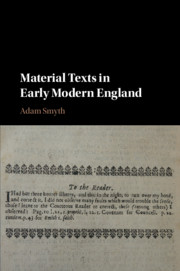Book contents
- Material Texts in Early Modern England
- Material Texts in Early Modern England
- Copyright page
- Dedication
- Contents
- Figures
- Acknowledgements
- Introduction: ‘the Case of Man’
- Chapter 1 Cutting Texts: ‘Prune and Lop Away’
- Chapter 2 Burning Texts: ‘His Studyeing Chaire … Was of Strawe’
- Chapter 3 Errors and Corrections: ‘My Galley Charged with Forgetfulness’
- Chapter 4 Printed Waste: ‘Tatters Allegoricall’
- Conclusion
- Appendix: Sample Instances of Printed Waste
- Bibliography
- Index
- References
Bibliography
Published online by Cambridge University Press: 21 December 2017
- Material Texts in Early Modern England
- Material Texts in Early Modern England
- Copyright page
- Dedication
- Contents
- Figures
- Acknowledgements
- Introduction: ‘the Case of Man’
- Chapter 1 Cutting Texts: ‘Prune and Lop Away’
- Chapter 2 Burning Texts: ‘His Studyeing Chaire … Was of Strawe’
- Chapter 3 Errors and Corrections: ‘My Galley Charged with Forgetfulness’
- Chapter 4 Printed Waste: ‘Tatters Allegoricall’
- Conclusion
- Appendix: Sample Instances of Printed Waste
- Bibliography
- Index
- References
- Type
- Chapter
- Information
- Material Texts in Early Modern England , pp. 190 - 205Publisher: Cambridge University PressPrint publication year: 2018



